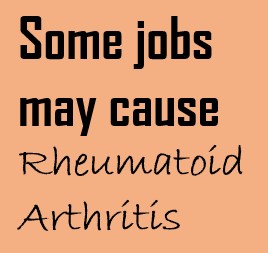A Swedish study suggests that workers exposed to airborne toxins may have an increased risk of developing rheumatoid arthritis (RA), an immune system disorder that causes swelling and pain in the joints.
The study found that among men, bricklayers, concrete workers, manual load handlers and electricians were at twice the risk or more to develop rheumatoid arthritis than if they would have been in certain other occupations. In women, nursing jobs had a 30% higher risk than other jobs.
Compared with men working desk jobs, electrical workers had twice the risk of rheumatoid arthritis and bricklayers and concrete workers had roughly triple the risk.
The lead author Anna Ilar of the Karolinska Institute in Sweden said, “Previous studies have indicated that occupations within the manufacturing sector are associated with an increased risk of rheumatoid arthritis.”
Anna further emphasized, “The novelty of our findings is that we showed that occupations within this sector are related to an increased risk of rheumatoid arthritis even after controlling for lifestyle-related factors including smoking, alcohol use, education and obesity.”
Smoking is a known risk factor for rheumatoid arthritis, but the findings of this study add to evidence suggesting that environmental factors could trigger the disease in some people engaged in jobs in such settings.
Earlier research suggested that lung changes caused by inhaled pollutants may trigger immune responses that lead to rheumatoid arthritis, particularly in individuals with a genetic predisposition for the disease.
For this study, researchers examined data on 3,522 people with rheumatoid arthritis and 5,580 similar individuals without the condition. Information was gathered on work history from questionnaires and results analyzed from blood samples looking for genetic factors that can contribute to the disorder.
Researchers compared the increased risk of rheumatoid arthritis in manufacturing occupations to the risk associated with professional, administrative and technical jobs that tend to involve deskwork rather than manual labor.
Compared with men working desk jobs, electrical workers had twice the risk of rheumatoid arthritis and bricklayers and concrete workers had roughly triple the risk.
The study didn’t find an increased risk of rheumatoid arthritis for women working in the manufacturing sector, but this could be due to too few women in these jobs to properly analyze the impact of this work.
It’s possible that inhaled toxins such as silica, asbestos, organic solvents and motor exhaust might have contributed to the development of rheumatoid arthritis, but the study didn’t analyze which pollutants caused the condition.
One limitation of the study is that researchers assumed people in professional jobs in doing office work didn’t have exposure to toxins that may increase the odds of rheumatoid arthritis. The study also wasn’t a controlled experiment designed to prove whether or how certain occupations might cause rheumatoid arthritis.
Triggers to the immune system, both at home and workplace may increase the chance for an abnormal response by the immune system leading to any autoimmune disease, rheumatoid arthritis being one.
They also didn’t directly examine the influence of manual labor on development of rheumatoid arthritis, said Kaleb Michaud, a researcher at the University of Nebraska Medical Center and co-director of the National Data Bank for Rheumatic Diseases.
Michaud, who wasn’t involved in the study said, “There is some evidence that greater physical labor, which can cause more stress on the body physically and mentally, can lead to rheumatoid arthritis.”
“Not getting enough sleep and continuous repetitive tasks can lead to added stress that can impact your immune system,” Michaud added. “The more triggers to the immune system just increase the chances for an irregular response by it that may lead to an autoimmune disease like rheumatoid arthritis.”
The study published in Arthritis Care and Research in 2017 alerts the Occupational Health (OH) physician to be vigilant to environmental factors as they could trigger a lot of health issues in the workers.
Rheumatoid arthritis (RA) is an autoimmune disease and autoimmune reactions may be provoked by harmful airborne exposures.
Despite the results presented in the study published today, the authors say there is still much to be done in order to understand the specifics of how certain work factors affect RA risk.
“It is important to point out that you will not necessarily develop rheumatoid arthritis just because you have had a certain occupation or have been exposed to potentially harmful exposures at work,” said Ilar.
“But, airborne exposures may lead to a greater risk of rheumatoid arthritis,” she added. “That is why it is important that findings on preventable risk factors are spread to employees, employers, and decision-makers in order to prevent disease by reducing or eliminating known risk factors.”
The conclusion of the research so far is not to generate a fear among employees and employers as there is likelihood of many other factors that can cause or trigger development of rheumatoid arthritis but be mindful and reduce the known risk factors in order to prevent any chance of developing rheumatoid arthritis.
A program to identify and mitigate the threat to health by airborne particles should be established in both in offices and factories, especially as silica, asbestos, organic solvents and motor exhaust are known to negatively impact health. An Occupational Hygienist (Industrial Hygienist) can support such a program!
To know more, contact
___________________________________________________________________________________________
Dr Ajay Sati is an Occupational Health physician who prefers to describe himself as an Occupationist, to denote, ‘an expert in diseases and other concerns of occupations’. Dr Sati has managed health and wellness programs in industries he worked, like the atomic energy, and energy (oil & gas) in India and overseas. An experienced virtual consultation expert he was involved in many greenfield and brownfield projects providing inputs from health point of view. He is currently involved in a health startup.



